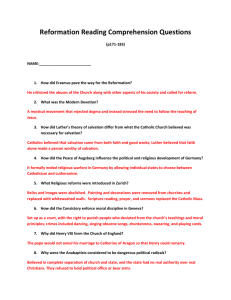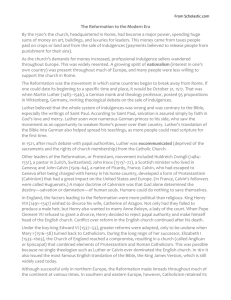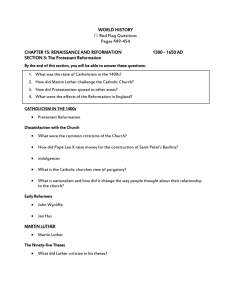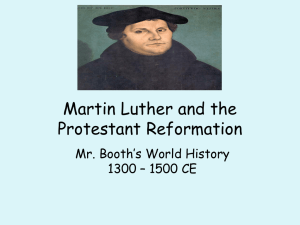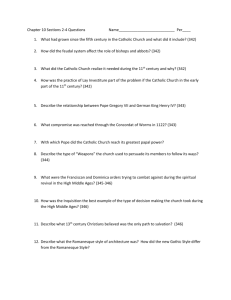Mercado--Reformation - Hinsdale South High School
advertisement
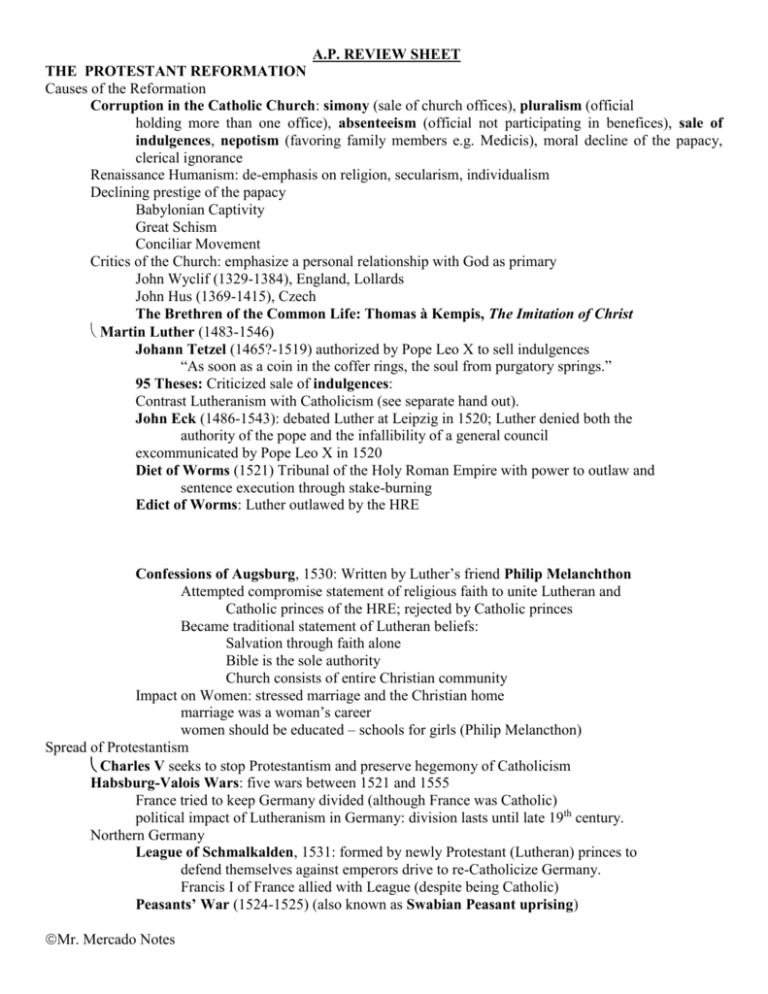
A.P. REVIEW SHEET THE PROTESTANT REFORMATION Causes of the Reformation Corruption in the Catholic Church: simony (sale of church offices), pluralism (official holding more than one office), absenteeism (official not participating in benefices), sale of indulgences, nepotism (favoring family members e.g. Medicis), moral decline of the papacy, clerical ignorance Renaissance Humanism: de-emphasis on religion, secularism, individualism Declining prestige of the papacy Babylonian Captivity Great Schism Conciliar Movement Critics of the Church: emphasize a personal relationship with God as primary John Wyclif (1329-1384), England, Lollards John Hus (1369-1415), Czech The Brethren of the Common Life: Thomas à Kempis, The Imitation of Christ Martin Luther (1483-1546) Johann Tetzel (1465?-1519) authorized by Pope Leo X to sell indulgences “As soon as a coin in the coffer rings, the soul from purgatory springs.” 95 Theses: Criticized sale of indulgences: Contrast Lutheranism with Catholicism (see separate hand out). John Eck (1486-1543): debated Luther at Leipzig in 1520; Luther denied both the authority of the pope and the infallibility of a general council excommunicated by Pope Leo X in 1520 Diet of Worms (1521) Tribunal of the Holy Roman Empire with power to outlaw and sentence execution through stake-burning Edict of Worms: Luther outlawed by the HRE Confessions of Augsburg, 1530: Written by Luther’s friend Philip Melanchthon Attempted compromise statement of religious faith to unite Lutheran and Catholic princes of the HRE; rejected by Catholic princes Became traditional statement of Lutheran beliefs: Salvation through faith alone Bible is the sole authority Church consists of entire Christian community Impact on Women: stressed marriage and the Christian home marriage was a woman’s career women should be educated – schools for girls (Philip Melancthon) Spread of Protestantism Charles V seeks to stop Protestantism and preserve hegemony of Catholicism Habsburg-Valois Wars: five wars between 1521 and 1555 France tried to keep Germany divided (although France was Catholic) political impact of Lutheranism in Germany: division lasts until late 19th century. Northern Germany League of Schmalkalden, 1531: formed by newly Protestant (Lutheran) princes to defend themselves against emperors drive to re-Catholicize Germany. Francis I of France allied with League (despite being Catholic) Peasants’ War (1524-1525) (also known as Swabian Peasant uprising) Mr. Mercado Notes A.P. REVIEW SHEET Twelve Articles,1525: peasants demanded end of manorialism (feudalism) Inspired by Luther; Luther opposed to violence and peasant movement As many as 100,000 peasants killed Anabaptists, John of Leyden (1509-1536): voluntary association of believers with no connection to any state Munster: became Anabaptist stronghold; tragedy at Munster—Protestant and Catholic forces captured the city and executed Anabaptist leaders Mennonites: founded by Menno Simmons became descendants of Anabaptists Millennarians: sect that expected imminent return of Christ Unitarianism: denied deity of Christ but believed in Christian principles. Michael Servetus a major figure Luther’s views on new sects and the peasantry: did not believe in violent protest nor legitimacy of any other faith except mainstream Protestantism Denmark, Sweden became Lutheran Ulrich Zwingli (1484-1531), established leadership in Zurich Colloquy of Marburg (1529): Zwingli splits with Luther over issue of Eucharist John Calvin (1509-1564) Institutes of the Christian Religion (1536) Calvinism: predestination, the “elect,” Puritan or Protestant work ethic. Most militant and uncompromising of all Protestants Calvin established a theocracy in Geneva Michael Servetus (1511-1553): Unitarian beliefs; burned at stake Spread of Calvinism: far greater impact on future generations than Lutheranism Presbyterianism in Scotland, John Knox (1505-1572); presbyters governed church Huguenots – French Calvinists; brutally suppressed in France Dutch Reformed – United Provinces of the Netherlands. Puritans and Pilgrims (a separatist minority) in England; established colonies in America Countries where Calvinism did not spread: Ireland, Spain, Italy – heavily Catholic Reformation in England John Wycliffe (1329-1384): Lollards Henry VIII: 2nd of Tudor kings—considered a “New Monarch” initially strong ally of Pope: Defense of Seven Sacraments; “Defender of the Faith” Cardinal Thomas Wolsey: failed to get Henry’s divorce excommunication by Pope Paul III Thomas Cranmer, 42 Articles of Religion: grants Henry his divorce Church of England (Anglican Church) Act of Supremacy (1934): King is now the head of the English Church Execution of Thomas More 1539, Statute of the Six Articles: Henry attempts to maintain certain Catholic sacraments Thomas Cromwell: Oversaw development of king’s bureaucracy Mary Tudor (r. 1553-1558) tries to reimpose Catholicism Marian exiles: Protestant sympathizers flee and come back to support Elizabeth I Elizabeth I (r. 1558-1603) – the “Virgin Queen” effectively oversaw the development of Protestantism in England Mr. Mercado Notes A.P. REVIEW SHEET Mary Stuart (“Bloody Mary”) executed 1563, Thirty-Nine Articles: defined creed of Anglican Church Anglican Church under Elizabeth I Puritans and Pilgrims (Separatists) sought to reform the church; Pilgrims left for Holland and then America THE CATHOLIC COUNTER REFORMATION (also called Catholic Reformation) Pope Paul III: Most important pope in reforming the Church and challenging Protestantism New Religious Orders Ursuline order of nuns (1544): Sought to combat heresy through Christian education Jesuits (Society of Jesus) (1540): 3 goals—reform church through education, preach Gospel to pagan peoples, fight Protestantism Ignatious Loyala (1491-1556): founder; organized in military fashion Spiritual Exercises: contained ideas used to train Jesuits Beginning in 1542, oversaw Spanish and Italian Inquisitions Spain: persecution of Mariscos (Christian Moors) & Marranos (Christian Jews) Succeeded in bringing southern German and eastern Europe back to Catholicism Sacred Congregation of the Holy Order, 1542, in papal states: Roman Inquisition Index of Prohibited Books: catalogue of forbidden reading Ended heresy in Papal States; rest of Italy not affected significantly Council of Trent (3 sessions 1545-1563): established Catholic dogma four next 4 centuries Equal validity of Scripture, Church traditions, and writings of Church fathers Salvation by both “good works’ and faith 7 sacraments valid; transubstantiation reaffirmed Monasticism, celibacy of clergy, and purgatory reaffirmed approved Index of Forbidden Books Church reforms: abuses in sale of indulgences curtailed, sale of church offices curtailed, Bishops given greater control over clergy, seminaries established to train priests Peace of Augsburg, 1555: Cuius regio,eius religio—“whose the region, his the religion.” Princes in Germany can choose Protestantism or Catholicism Resulted in permanent religious division of Germany Results of Reformation The unity of Western Christianity was shattered: Northern Europe (Scandinavia, England, much of Germany, parts of France, Switzerland, Scotland) adopted Protestantism. Religious enthusiasm was rekindled – similar enthusiasm not seen since far back into the Middle Ages. Abuses remedied: simony, pluralism, immoral or badly educated clergy were considerably remedied by the 17th century. Religious wars broke out in Europe for well over a century. Marx and Weber theses: Marx: capitalism (work ethic) led to Protestantism – favored by middle class Weber: capitalism furthered Protestantism but did not cause it. Mr. Mercado Notes A.P. REVIEW SHEET RELIGIOUS WARS: 1560-1648 Treaty of Cateau-Cambrèsis, 1559: ends Habsburg Valois Wars (last purely dynastic wars) France kept Holy Roman Empire from gaining hegemony in Germany, inadvertently helping Lutheranism to spread Catholic Crusade Philip II (1556-98): fanatically seeks to reimpose Catholicism in Europe Escorial: new royal palace (and monastery and mausoleum) in shape of grill Battle of Lepanto: Spain defeated Turkish navy off coast of Greece (reminiscent of earlier Christian Crusades) Spain v. England Queen Mary Tudor (Philip’s wife) reimposes Catholicism in England Queen Elizabeth I reverses Mary’s edict Elizabeth helps Protestant Netherlands gain independence from Spain Spanish Armada, 1588: French civil wars (at least 9 in last half of 16th c.) Concordat of Bologna, 1516: French monarchy now controlled Gallican Church War of the Three Henrys: civil wars between Valois, Guise, and Huguenot faction Catharine de’ Medici: (a Valois) opposed to Huguenots and Catholic Guise family St. Bartholomew Day Massacre: Huguenots massacred at Catherine’s order Henry of Navarre (Henry IV) (1553-1610): first Bourbon king Edict of Nantes, 1598: granted religious toleration to Huguenots politiques: monarchs who favor practical solutions (rather than ideological) Netherlands William I (William of Orange) (1533-1584), led 17 provinces against Inquisition United Provinces of the Netherlands,1581 (Dutch Republic) Spanish Netherlands (modern-day Belgium) closing of the Scheldt River: demise of Antwerp and rise of Amsterdam Thirty Years’ War (1618-1648) – most important war of the 17th century Failure of Peace of Augsburg, 1555 Four phases of the war: Bohemian Defenestration of Prague: triggers war in Bohemia Protestant forces eventually defeated; Protestantism eliminated in Bohemia Danish: height of Catholic forces during the war Albrecht von Wallenstein (1583-1634): paid by emperor to fight for HRE Edict of Restitution (1629): emperor declared all church territories secularized since 1552 automatically restored to Catholic Church Swedish: Protestants liberate territory lost in previous phase Gustavus Adolphus: pushed back Catholic forces back to Bohemia Battle of Breitenfeld, 1630 Emperor annuls Edict of Restitution French: “International Phase” Cardinal Richelieu allied with Protestants (like in earlier Hapsburg-Valois Wars) Treaty of Westphalia (1648): ended Catholic Reformation in Germany Renewal of Peace of Augsburg (but added Calvinism as accepted faith) Mr. Mercado Notes A.P. REVIEW SHEET Dissolution of Holy Roman Empire confirmed Dutch and Swiss independence 300+ German states became sovereign Results of 30 Years’ War Germany physically devastated (as much as 1/3 of pop. in certain areas perished) End to wars of religion Beginning of rise of France as dominant European power; also Britain & Netherlands Mr. Mercado Notes

